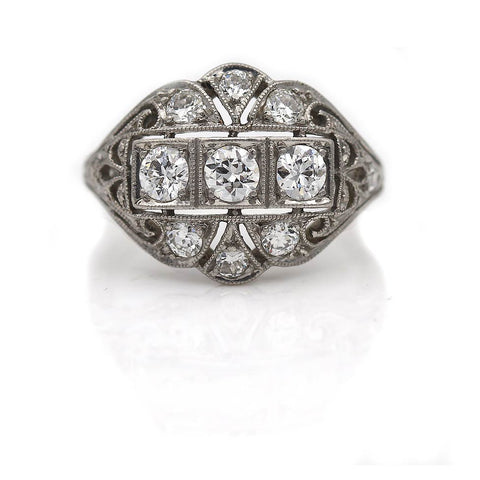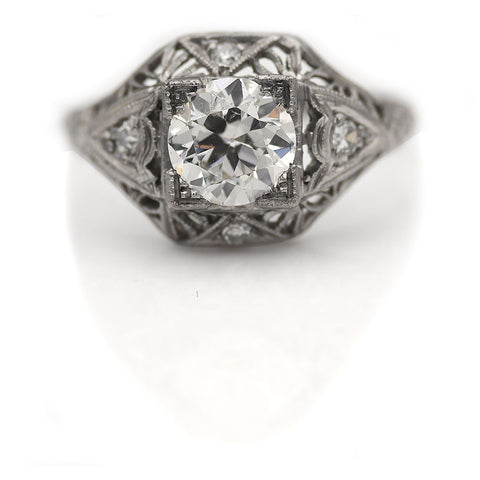What is Milgrain? | The Definitive Guide to Milgrain Rings (2024)
by Suzanne Sachs • 5 min read
THE BASICS --
Milgrain can be a stunning accent on an engagement ring, Art Deco ring, dinner ring, anniversary ring, wedding band, or any other piece of jewelry. But what exactly is milgrain? What should you be aware of before purchasing a piece featuring this detail?
WHAT YOU NEED TO KNOW--
In this guide, we will explain the following:
- What is Milgrain?
- What Milgrain is Not
- Is Milgrain Right For You?
- Pros of Milgrain Rings
- Aesthetic Appeal
- Texture and Depth
- Unique and Distinctive
- Ethical Diamonds
- Vintage Settings
- Cons of Milgrain Rings
- Maintenance
- Durability
- Cost
- Buying a Milgrain Ring
- Caring For Milgrain
- Choosing a Milgrain Ring
What Is Milgrain?
Milgrain is a decorative technique used in jewelry that involves creating a series of tiny beads or dots along the edges or surfaces of a piece. This technique is often used to add an antique or vintage look to jewelry and can be found on engagement rings, wedding bands, earrings, and other pieces. Milgrain detailing can enhance the overall design by adding texture, depth, and a touch of elegance, making the piece appear more intricate and refined.
The term "milgrain" comes from the French word "mille-grain," meaning "a thousand grains," which accurately describes the intricate beaded texture. Milgrain has been used in jewelry for centuries, with its intricate beading technique enhancing pieces from various eras and styles. Milgrain gained prominence during the Edwardian and Art Deco periods, where it was used to accentuate the delicate and geometric designs of engagement rings, wedding bands, and other fine jewelry, often crafted in platinum. Victorian jewelry also featured milgrain, adding texture and dimension to ornate and romantic pieces.
Platinum and gold are the most common metals used for milgrain detailing not only for their beauty but also for their durability and ability to showcase fine, intricate work. Silver is also used for milgrain, particularly in more affordable pieces, but it is somewhat less common due to its tendency to tarnish.
What Milgrain Is Not
Milgrain is not simply an ornamental border; it is a specific beading technique used to create texture and detail on the edges or surfaces of jewelry. It is not engraving, which involves carving designs directly into the metal, nor is it filigree, which consists of intricate metalwork made from delicate threads of metal. Milgrain is also not a type of setting for gemstones; rather, it is a decorative element that can enhance various settings.
Is Milgrain Right for You?
There is no doubt that milgrain is stunning, but it isn’t necessarily right for everyone. Someone with very delicate fingers, for example, might find a cocktail ring with extensive milgrain to appear too bold or heavy. If your personal jewelry preferences lean towards clean lines and a more delicate look, large amounts of milgrain might not appeal to you.
A love for romantic aesthetics and an appreciation for antique and vintage styles can make milgrain detailing a perfect match. This style is ideal for anyone who desires a standout piece or values elaborate designs and rich texture in their jewelry.
Pros Of Milgrain Rings:
Understanding the pros and cons of this type of jewelry is essential before committing to milgrain pieces. While milgrain offers great beauty, it also comes with certain considerations.
• Aesthetic Appeal
Milgrain detailing adds an intricate, decorative touch to jewelry, giving it a vintage or antique look that many find charming and elegant. A vintage milgrain ring combines classic design elements with intricate detailing, making it a perfect choice for someone who appreciates historical styles and fine artistry.
• Texture and Depth
The tiny bead-like patterns create a textured effect, enhancing the visual interest and complexity of the piece. The intricate milgrain edging adds texture and dimension to the ring, enhancing the overall brilliance and appeal of the gemstone it surrounds.
• Unique and Distinctive
Milgrain jewelry stands out due to its distinctive design, making it a perfect choice for those who want a unique and memorable piece. The detailed work can accentuate the design of the jewelry, highlighting specific elements and adding to the overall beauty.
• Ethical Diamonds
Many socially-conscious couples worry that their milgrain ring might contain conflict diamonds, which are stones sold to finance civil wars, terrorism, or human rights abuses. Since these concerns primarily emerged in the early 1990s, older rings are generally not associated with conflict stones. As a result, couples can feel confident that their vintage ring did not contribute to these historical atrocities.
• Vintage Settings
In addition to using ethically sourced stones, milgrain rings are an environmentally considerate choice for eco-conscious couples. Vintage and antique rings eliminate the need for additional mining, shipping, or processing—activities that can lead to habitat destruction, pollution, and greenhouse gas emissions. These rings, already beautifully crafted and rich in history, are ready to be cherished anew, reducing environmental impact and promoting sustainability.
Cons Of Milgrain Rings:
While they do have many benefits, it is equally important to consider the potential negative points before purchasing a milgrain ring, including…
• Maintenance
The intricate detailing of milgrain can make it more difficult to clean and maintain, as dirt and debris can easily get trapped in the tiny beads.
• Durability
Over time, the small beads may wear down, especially with frequent wear, potentially diminishing the intricate look.
• Cost
The added craftsmanship required for milgrain detailing can increase the cost of the jewelry piece.
Buying a Milgrain Ring
If you are ready to choose a milgrain piece, whether it’s a ring or another type of jewelry, visit different retailers to explore their collections. Try out different pieces and designs to find the styles you like best. Examine your favorites closely to see which milgrain patterns attract you most, and ask about the history of each piece to learn what makes it unique.
Caring for Milgrain
Caring for milgrain jewelry requires special attention to preserve its intricate details and maintain its beauty over time. Gently clean your milgrain pieces with a soft brush and mild soap solution, avoiding harsh chemicals and abrasive cleaners that can damage the delicate beading. Store your jewelry separately in a soft-lined box or pouch to prevent scratches and wear.
Periodically, take your milgrain jewelry to a professional jeweler for thorough cleaning and inspection to ensure the beads remain intact. Additionally, handle your jewelry with care, avoiding rough activities that could cause damage. By following these tips, you can keep your milgrain jewelry looking stunning and preserve its intricate beauty for years to come.
Choosing a Milgrain Ring
Understanding what milgrain is and weighing its pros and cons are crucial when deciding if a milgrain ring is the right symbol for your relationship. Ultimately, the choice is personal. Finding a vintage ring you adore and that represents your shared love is a delightful challenge as you take this first step toward wedded bliss.
Antique Engagement Rings For Everyone:
No matter which era is your favorite, these time-honored rings have a rich history and individualized character and will continue to have a timeless beauty and elegant appeal that is part of a legacy to pass on to future generations.
Find The Perfect Engagement Ring:
Antique diamond cuts are prized not only for their beauty but also for their exquisite attention to detailing and faceting. If you’re looking for a ring with a sense of glamour, sophistication and vintage charm, explore our collection of Milgrain Engagement Rings today!
Suzanne Sachs
Press Love:
Contact Suzanne
If you love vintage or eco-friendly jewelry please feel free to contact Suzanne or browse our collection of eco-friendly vintage engagement rings.






















Leave a comment